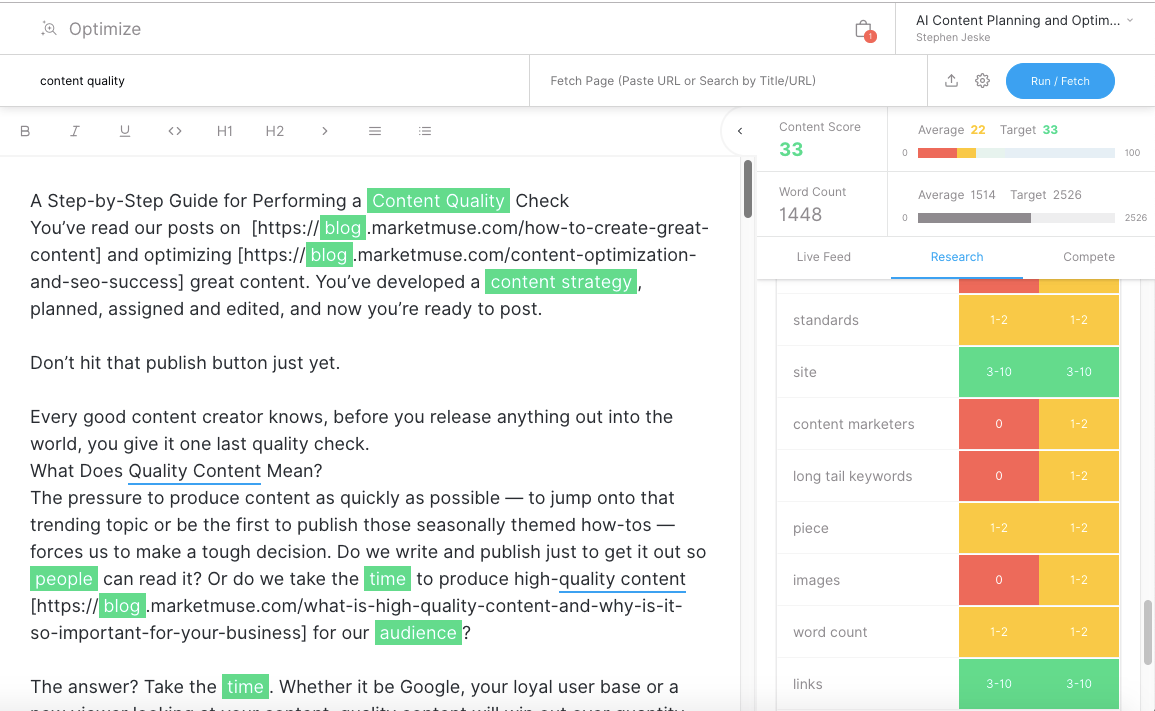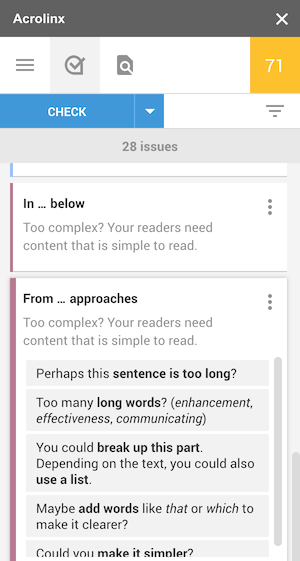Content Quality Check Step By Step
Rob Frierson • December 2, 2019

Content Quality Check Step by Step
You’ve read our posts on creating and optimizing great content. You’ve developed a content strategy, planned, assigned and edited, and now you’re ready to post.
Don’t hit that publish button just yet.
Every good content creator knows, before you release anything out into the world, you give it one last quality check.
What Does Quality Content Mean?
The pressure to produce content as quickly as possible — to jump onto that trending topic or be the first to publish those seasonally themed how-tos — forces us to make a tough decision. Do we write and publish just to get it out so people can read it? Or do we take the time to produce high-quality content for our audience?
The answer? Take the time. Whether it be Google, your loyal user base or a new viewer looking at your content, quality content will win out over quantity every time.
There’s a lot of information out there, which makes readers (and search engines) skeptical of anything they come across. To prove that you’re worthy of their time, your content must fulfill a need for your audience in a clear and trustworthy way.
To do so, it must be original, well-researched content that is grammatically and factually correct. It should rely on reliable sources and contain links that go to the right places.
There are key elements to every content quality check. We’ve listed them below. Print them out, if you like, or paste them somewhere on your desktop. Then run through them every time you audit, optimize or create new content for your content marketing efforts.
Step 1: Check Your Quality Content Score
The biggest challenge is taken a qualitative factor, like content quality, and turning it into something quantitative. But that step is critical if you want to take a data-driven approach to SEO content, as opposed to relying on your gut. Plus, it’s the only way to realistically scale the content creation process.
To be clear, content score has nothing to do with word count. Longer posts aren’t inherently better, they just have more words. Thin content can be of lower quality, but that too is no guarantee. Real subject matter experts can typically convey more information using fewer words.
Underpinning the concept of content quality is the idea that the in-depth content is that which thoroughly covers important related subtopics. For example, if I’m discussing content quality, then I should talk about the audience, content scoring, search engines, and other concepts.
You can conduct a content audit after the fact, but you may find it easier to work content scoring into the content creation process. In this case, you’ll have specific quality standards to aim for when putting together the article. In the example above we’re aiming for a content score of 33 based on how well other top-ranking pages have covered the subject.
All things being equal, if we achieve that score, we have a realistic chance at ranking well.
Step 2: Check Your Content for Originality
Before you even assign and create content, you should check to make sure your idea is original. If it’s a well-covered topic you want to rank on, make sure you’re taking a new spin on it.
You can do that by Googling keywords manually and seeing what pops up. If your topic has been done to death, or if some other site owns the ranking on that topic, you can find a different angle or move on.
But there are tools out there that will help you speed up the process.
SEMRush, for instance, can help you get a more comprehensive picture of topic coverage. Plug in a topic or keyword you’d like to cover, and they’ll give you a list of trending articles and related topics.
MarketMuse Suite can also help you plan quality, original content. By comparing your topic coverage with that of your competitors, you can see where your current content is overlapping and where you can differentiate. It can also help you choose new topics to target that have not yet been covered.
If you’ve already written your article — or if someone wrote it for you — a good plagiarism tool like Copyscape or Grammarly will keep you from duplicating content that appears somewhere else online.
The free version of Copyscape checks to make sure none of your content has been copied elsewhere, while the premium version lets you check new content for duplication before you publish it.
Grammarly detects duplicate content within your text as you write and edit.
Step 3: Check Your Content for Grammar and Spelling
There’s no two ways about it. Bad grammar and poor spelling hurt your credibility. And while Google doesn’t necessarily crawl for sloppy writing, you can bet your users will notice.
As we mentioned in our post on thin content, grammar and spelling mistakes tell your reader that you didn’t make much of an effort to create quality content. And if you didn’t bother to edit your piece, who’s to say you took the time to research the topic or vet your sources?
When you put your content calendar together, schedule enough time for one or two rounds of editing. Even after you feel like you have a good final draft, take it through one more editorial check.
You can also recommend writers use a tool like Grammarly, or the editing functions in Word or Google Docs, to check spelling and grammar as they write. Your editorial team can use them, too. In the haste to get content out the door, editors can introduce errors without realizing it.
Step 4: Check Your Content for Brand Consistency
Writing teams often face the challenge of ensuring each piece of content produced reflects the standards of your brand. In theory, a style guide should help. But that only works if writers and editors reference that material. They’ll read it once if you’re lucky.
Acrolinx is an AI-powered platform that helps enterprises ensure their content is consistently on-brand and on-strategy. The best part is that it’s integrated into the workflow, which is the only practical way of ensuring content meets corporate standards.
Acrolinx records your company’s requirements for style, terminology and tone. During the process of creating content, the software provides in-line feedback that includes an Acrolinx Score. That score is a key part of ensuring alignment and makes it simple to check. A higher score means better content.
Step 5: Check Your Content for Reliable Sources
When your writer turns in a new piece, they should include linked sources throughout. Connecting to sources right in an article serves three purposes:
- It signals to Google that you’re providing high-quality content that is thoroughly researched.
- It signals to your readers that the information has been verified and is therefore trustworthy.
- It makes your fact-checking work a lot easier.
But there’s a catch: You can’t cite information from any old source out there and call it a day. Your data should come from trusted sources that, just like you, provide thorough, well-researched content.
University and government research are generally trustworthy, as are museums and national publications like The New York Times and National Geographic.
It’s important to get to know the trusted sources within your field, as well. If you’re in healthcare, for example, the Mayo Clinic and the National Institutes of Health are good sources.
But even these guys get things wrong sometimes. That’s why it’s important not only to check sources but to check facts, too.
Step 6: Fact-Check Your Content
Fact-checking content takes a little more elbow grease. While Google does have a beta version of a fact-checking search engine, there aren’t really any tools that can scan and verify factual information.
For that, you’ll need to dig in and research.
Click through all of the sources your writer gave you to make sure they got their facts straight.
Check all statistics and historical information using the trustworthy sources I mentioned above. Verify dates, names, titles, and places. Make sure any definitive statement or claim made by your article is correct.
If you don’t have a source and you’re not sure where to start, you can paste the segment you want to check into a Google search and see what comes up. Make sure your fact shows up in two or three trusted places before you call it a day.
Step 7: Check Your Content for Broken Links
The internet is in constant flux. Organizations renovate their sites all the time. They move, archive or retire content. And some sites shut down altogether.
When something moves or disappears, and a site hasn’t provided a redirect, you’re left with a broken link on your site.
Too many broken links tell Google that your content may not be as trustworthy as it once was. It also signals to your readers that your content is outdated and you haven’t bothered to update it.
Checking for broken source links in your content should be a regular habit. And there are all kinds of tools that can help you do that.
In the past, I’ve used a Chrome extension called Link Checker to crawl links on individual pages. Just run the checker, and it will highlight all links on your page in green, red or yellow — green for good links, red for broken ones and yellow for redirects or links that are slow to respond.
If you want to check links across entire sections of your site — or across the whole thing — Screaming Frog and SEMRush both crawl for broken links.
If you want to rank well with your content and show your users that you really care about their needs, take the time to produce the best content possible. Bad-quality content costs more in the end anyway. So before you hit that publish button, run through your quality content checklist to make sure you truly are putting your best foot forward.
Featured image vector designed by Freepik
















